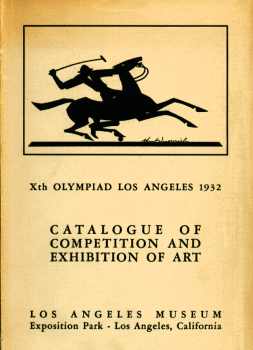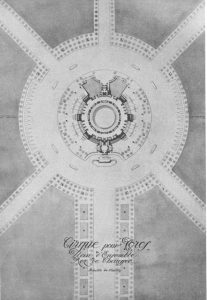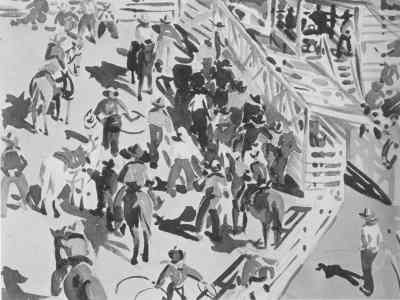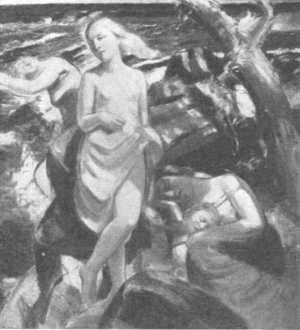Olympic Art Competition
| A r t C o m p e
t i t i o n s a n d E x h i b i t i o n
During the era of the modern Olympiads it has been natural for the Sports phases of the Games to become emphasized in the public mind. However, in the revival of the modern Games the founders of the new movement instituted competitions in the Arts alongside of the Sports, just as they were associated in the ancient Grecian festivals. It has been more difficult to forward the Art competitions, but the Olympic organizations have not failed to recognize their responsibility and to give full weight to the value of preserving and encouraging the cultural side of the Games. With this responsibility in mind, the Organizing Committee gave early attention to the organization of the Art Competitions, this item being the first definitely provided for in the budget, almost three years before the celebration of the Games. The next step was the appointment of General Charles H. Sherrill, member of the International Olympic Committee for the United States and a recognized leader in the advancement of the Olympic Arts, as chairman of the special committee to undertake the organization of this important activity of the Games of the Xth Olympiad. In formulating plans, it was decided to follow the example of previous Olympiads and include an Exhibition of Art in connection with the prescribed Art Competitions. The American Federation of Arts in Washington was consulted by General Sherrill, and Mr. Homer Saint-Gaudens, Director of the Art Department of the Carnegie Institute, Pittsburgh, was requested to make an estimate of the probable cost of the Art Competitions and Exhibition. Mr. Saint-Gaudens had for a number of years assembled international exhibitions of paintings at the Carnegie Institute, and was therefore especially competent to make such an estimate. The amount he named was approved by the Organizing Committee and was placed in the hands of the American Federation of Arts, this national organization having consented to assume the responsibility. The work of assembling the American exhibits was assigned to Miss Leila Mechlin, Secretary of the American Federation of Arts, and the organizing of the European exhibits was entrusted to Mr. Guillaume Lerolle, the foreign representative of the Carnegie Institute. The Olympic Committees of the various European nations in every instance assumed the responsibility of assembling their own exhibits, but a certain allowance was made to each for the cost of transportation, insurance, and other expenses, and arrangements for forwarding and returning the exhibits were made by or through Mr. Lerolle. According to the original agreement, the American Federation of Arts was to be responsible solely for the American Section and for the general supervision of the Exhibit, but owing to the ppointment of General Sherrill as Ambassador to Turkey early in 1932, and his immediate departure for his post, the entire management of the Competitions and Exhibition was delegated to Miss Mechlin, representing the American Federation of Arts. For
the most part the foreign countries
forwarded their exhibits by steamship via the Panama Canal direct to
Los
Angeles. Through special arrangement with the United States Customs
Bureau,
all exhibits were entered either free of duty or in bond, and unpacked
and repacked under customs supervision in the Los Angeles Museum, where
the exhibits were shown. In accordance with a general ruling covering
transportation,
all exhibits shown in an International Exhibition are sent by prepaid
freight
and returned by the carriers freight free. The foreign committees
insured
their respective exhibits in transit, but all exhibits were insured by
the American Federation of Arts for the The first European exhibits arrived in Los Angeles on May 15, 1932, and the last to be received arrived shortly after July 1. The exhibition opened simultaneously with the Games, on July 30, but continued until the end of August. The last exhibits were returned from Los Angeles October 1. The Exhibition was held in the Los Angeles Museum of History, Science and Art, which stands in Exposition Park (Olympic Park), opposite and at no great distance from Olympic Stadium. It occupied the foyer of the Museum, the main rotunda and adjacent halls, the small rotunda, and fifteen galleries. There were in all over 1100 exhibits, by artists of 31 nations. The countries represented were : Argentine, Austria, Belgium, Bulgaria, Canada, Czechoslovakia, Denmark, France, Germany, Great Britain, Guatemala, Holland, Hungary, Ireland, Italy, Japan, Latvia, Luxembourg, Mexico, Norway, Peru, Poland, Roumania, Salvador, Spain, Sweden, Switzerland, Turkey, Uruguay, Venezuela, and the United States. Source document: Official Report 1932, page 749 ff |

The prizes were awarded as follows:
ARCHITECTURE
Architectural Designs:
| 1932 | 1st | Gustave Saacke and | FRA | Circus for Bullfights |
| Pierre Montenot and | ||||
| Pierre Bailly | ||||
| 2nd | John Russel Pope | USA | Design for the Payne Whitney | |
| 3rd | Richard Konwiarz | GER | Plan of Silesian race course |

Circus for Bullfights, Gustave Saacke, Pierre Montenot and Pierre Bailly
Designs for Town Planning:
| 1932 | 1st | John Hughes | GBR | Design for a sports and recreation centre with stadium for the city of Liverpool |
| 2nd | Jens Hovmoller Klemmensen | DEN | Design for a stadium and public park | |
| 3rd | André Verbeke | BEL | Design for a Marathon Park |
SCULPTURE
Medals:
| 1932 | 1st | Józef Klukowski | POL | Sport Sculpture II |
| 2nd | Frederick William Mac Monnies | USA | Lindbergh Medal | |
| 3rd | Robert Tait McKenzie | CAN | Shield of the Athletes |

Sport Sculpture, Jozef Klukowski
Sculpture:
| 1932 | 1st | Mahonri Mackintosh Young | USA | Knockout |
| 2nd | Miltiades Manno | HUN | Wrestling | |
| 3rd | Jakub Obrovsky | TCH | Odyseus |

Knockout, Mahonri Mackintosh Young
Drawings and Water-Colors:
| 1932 | 1st | Lee Blair | USA | Rodeo |
| 2nd | Percy Crosby | USA | Jackknife | |
| 3rd | Gerhardus Westermann | NED | Horseman |

Rodeo, Lee Blair
Other Graphics Arts:
| 1932 | 1st | Joseph Webster Golinkin | USA | Leg Scissors |
| 2nd | Janina Konarska | POL | Stadium | |
| 3rd | Joachim Karsch | GER | Baton passing |
Paintings:
| 1932 | 1st | David Wallin | SWE | At the Seaside of Arld |
| 2nd | Ruth Miller | USA | Struggle | |
| 3rd | no prize was awarded |

At the Seaside of Arld, David Wallin
Literature - All Kinds:
| 1932 | 1st | Paul Bauer | GER | The Struggle with the Himalaya |
| 2nd | Joseph Petersen | DEN | The Argonauts | |
| 3rd | no prize was awarded |
Music - All Kinds:
| 1932 | 1st | no prize was awarded | ||
| 2nd | Josef Suk | TCH | March "Into a New Life" | |
| 3rd | no prize was awarded |
Merit for Alpinism:
| 1932 | 1st | Toni Schmid and | GER | First Ascension of the |
| Franz Schmid | Matterhorn North Side |